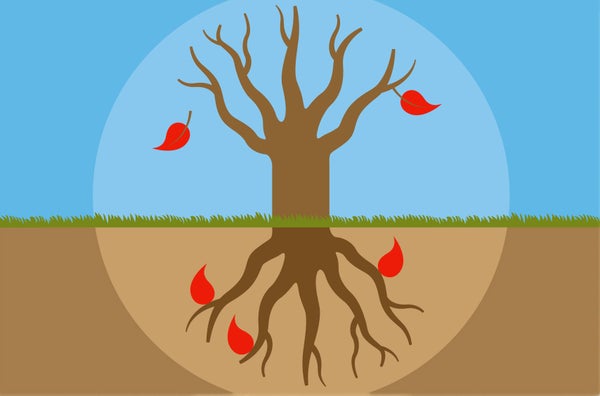Some wildfires just won't die—even though they're buried. Although temperatures and shortening days limit wildfire activity at the end of the Northern Hemisphere's summer, “zombie” fires can smolder underground all winter and reemerge in spring. In what investigators say is the first field study to examine how this phenomenon works and its ecological impacts, they found that the stealthy flames draw nourishment from a surprising subterranean source.
A satellite-based study published in 2021 revealed that zombie or “overwinter” fires are becoming more common in Arctic forests, probably because of climate change. It also demonstrated that sites of overwinter fires in Alaska and northern Canada could be identified via visual clues in satellite images (the locations were later confirmed by firefighters on the ground). For the new research, biologist Jennifer Baltzer of Canada's Wilfrid Laurier University and her colleagues used these data to choose nine overwinter sites for a closer look at the soil and vegetation involved.
Their results, presented at the General Assembly of the European Geosciences Union in April, were a surprise. Contrary to the hypothesis that overwinter fires sustain themselves in carbon-rich, organic soil layers known as peat, the researchers learned that most of them had burned in drier, upland sites with dense tree populations; the find suggested fires had instead smoldered underground in woody tree roots. “This is not what we were expecting,” Baltzer says.
On supporting science journalism
If you're enjoying this article, consider supporting our award-winning journalism by subscribing. By purchasing a subscription you are helping to ensure the future of impactful stories about the discoveries and ideas shaping our world today.
The discovery means carbon emissions from these underground fires may be lower than previously thought, and they may also have less of an effect on soil health and plant regeneration. Additionally, because these fires did not reach the forest canopy—instead felling trees by burning their roots—less plant material overall combusted than in many single-season fires the team visited. “In terms of emissions and ecological impact,” Baltzer says, “it may be a relatively good-news story.”
Still, researchers don't yet know how zombie fires affect global emissions. “If it burns underground in part of a tree, it's not releasing ancient carbon,” says Thomas Smith, who studies environmental geography at the London School of Economics and Political Science and was not involved in the study. But he notes that peat fires burning long-buried carbon do, worryingly, exist elsewhere, including Siberia. There, smoke rising from the snow in winter has evoked concern about peat-driven zombie fires.
The hot, dry conditions that lead to big wildfire seasons also support overwinter fires. And such fires may themselves be part of a positive-feedback cycle, reigniting to create even more fires in the next year. Closely examining more sites will help scientists determine what conditions support zombie fires, supporting efforts toward more reliable detection and effective firefighting, the researchers say.
